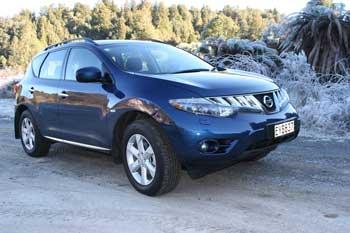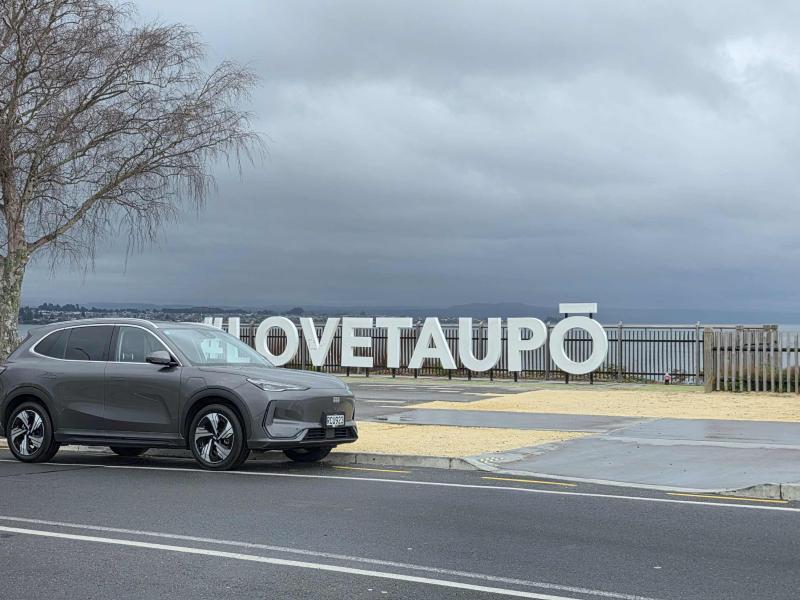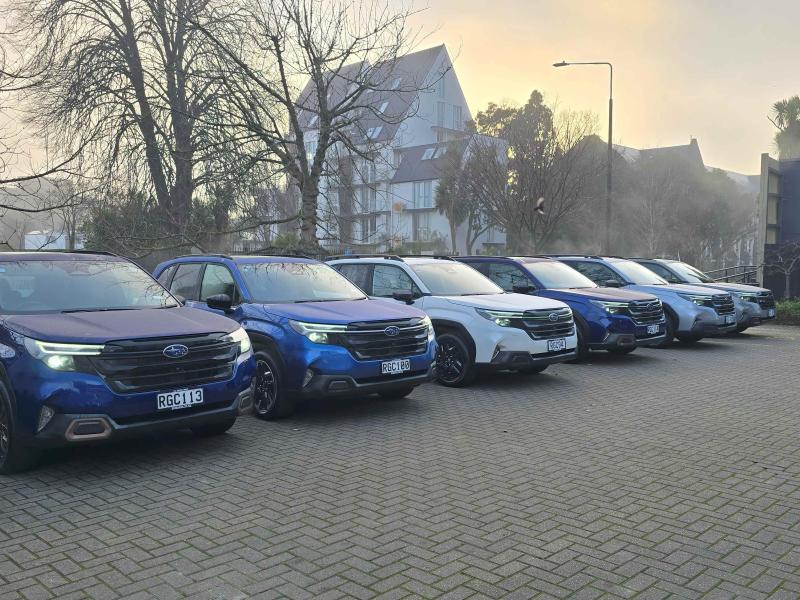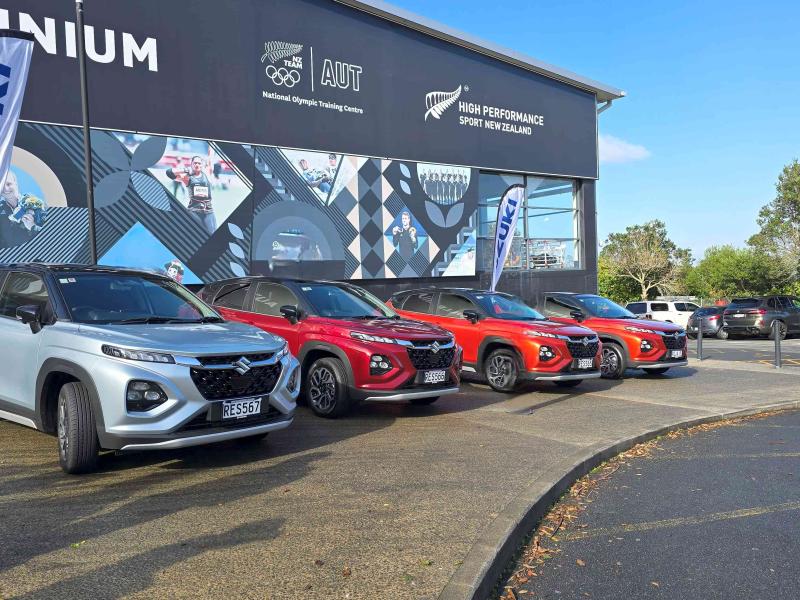|
IN SEARCH OF SNOW AND KIWIANA Story John Oxley, pictures Ashley Lucas and John Oxley Nissan is best known as a tough truck manufacturer, and its older short wheelbase Patrols in particular are much sought-after by those who want a cheap second-hand vehicle to modify for use in more extreme 4WD conditions. But times change, and the Patrol has given way to the robust Pathfinder and the softroader X-Trail in Nissan’s popularity stakes. But what about the Murano? Is this neither fish nor fowl, merely a 4WD road car - or a versatile vehicle capable of taking you that extra mile we are always talking about? The Murano was designed in the US, at Nissan’s California design studio, initially only for the American and Canadian markets, and was built on Nissan’s Altima FF-L platform. This explains why the styling is as brash as it is, with masses of chrome, and also why there were complaints about interior trim and finishes with the earlier models. However now Nissan has come out with a brand-new Murano, designed for both American and European markets, and it’s built on the entirely new D platform, as used on the latest Maxima, and although at first glance styling – except for a different grille design – appears to be much like the outgoing model, every single panel on the vehicle is new. The new platform is much stiffer – 150 percent stiffer in fact - and this makes the vehicle more responsive, both on-road and off. It’s also heavily reinforced in places to make it stronger for 4WD use, which means you’re not likely to have doors sagging and hinges breaking off as the vehicle gets older. You’ll spot the styling changes first around the front wheel arches, which are squared off and not as pronounced on the new version as on the old, but also around the rear three-quarter panels and especially at the back, where the rear valance has been cleaned up and the exhaust pipes fitted into neat triangular inserts. But the most obvious changes are to the nose and tail, with different head and LED taillight treatment, with horizontal lights in place of the vertical “stacking” lights of the original. It remains 1,885 mm wide, 1,730 mm tall, and sits on a 2,825 mm wheelbase, but at 4,835mm from bumper to bumper it is 65mm longer. The interior has also been completely redesigned, with the use of a more traditional instrument cluster and notably higher-quality materials. These include double stitched leather trim, real aluminium highlights, and an important feature in a 4WD used in the suburbs and especially where there are children, a built-in reversing camera. This latter feature is especially useful at night, for it operates well in low light. It’s also great when all your windows and mirrors are fogged up after the vehicle has spent a couple of hours outside and you can’t see to the rear or sides, as the camera is mounted in the rear number plate enclosure where it is unaffected. But we digress. The previous Murano’s dash looked a bit like a cheap Chinese boom box, with lots of plastic and plain surfaces. It just didn’t match its price point. The new version, though, is totally different, and it is clear a lot of work has gone into the well-padded and smoothly sculptured dash panel, with an instrument binnacle that looks modern and in keeping with the exterior upgrades. The instrument panel is now deeply recessed, where it is immune from reflections, with nicely chromed rings around the three “overlapping” dials, with the centre containing the speedo, that on the right the revcounter, and the left a fuel gauge plus odometer, trip meters, and the gearbox position display. And don’t go looking for the ignition key switch – there isn’t one. Instead the Murano comes with a proximity key which you keep in your pocket, and a simple pushbutton to start and stop the car on the right-hand side of the steering column. There’s a neat dropdown in the centre of the dash, trimmed with aluminium highlights, and this contains the audio/CD system and ventilation controls, with a display at the top showing radio and heating/ventilation selections, as well as doubling up as the reverse camera screen. Satellite switches for the audio system and cruise control are integrated into the V-shaped centre section of the leather-rimmed steering wheel. Cabin space is generous, especially in the back, though the deep dashboard, made necessary by the large steeply-sloping windscreen, seemed like acres of wasted space. The seats provide excellent support and comfort, and there’s a tilt adjustable steering wheel, while the heating and ventilation system now incorporates a mild flow vent which dissipates cool or warm air around the cabin rather than directly at its occupants. The front seats are power-operated and seats include a memory function on the driver’s side which includes preferred settings of the seat, steering wheel and door mirror positions for two drivers. The driver’s seat has eight-way adjustment, with four-way adjustment on the passenger side. We found it extremely easy to get comfy, and liked the high seating position which gave a good all-round view. However, shorter drivers had some difficulty seeing the front of the Murano, given its steep drop-off, while the thick rear three-quarter panel could have presented a problem while reversing were it not for the camera. The latest Murano, like its predecessor, gets Nissan’s award-winning 3.5-litre VQ 24-valve V6 engine as also found in the original 350Z (now upgraded to 3.7-litres in the latest Zee-car) and this pushes out 198 kW, a healthy 20 kW increase over that of the previous model, with a commensurate hike in torque, too, from 318 at 3600 to 334 Nm at 4400 rpm The changes feature variable induction and continuous valve timing control systems, as well as lots of detail improvements to reduce friction and enhance refinement. At the same time Nissan has done a lot of work to make the engine more economical. It’s a very smooth engine, and once you’re motoring you hardly hear it at all. You still climb up into the Murano, but it’s only a little climb, and it puts you in that commanding position we all prefer. Getting the right driving position is easy thanks to height and reach adjustment of the seat, plus tilt adjustment of the steering. Then a push of that button, and she roars into life, that V6 engine sounding lusty and powerful -which it is. Once on the road you’re immediately impressed by the ride quality of the new Murano, and how well it handles. The previous model suffered from more than a smidgen of understeer, but the latest version is much more neutral, thanks to the stiffer platform that is more resistant to lateral and twisting forces, as well as tweaks to the geometry of the new multi-link rear suspension and revised front strut suspension. The result is more responsive handling combined with improved levels of comfort. Speed sensitive power steering system also improves ease of driving at low speeds and gives a more direct feel at higher speeds. But there are two things missing from the latest car – as they were with the previous model – that make the Murano a near-miss when it comes to off-road driving, and that’s a low range gearbox and decent ground clearance, with the Murano allowing only 185 mm. However 4WD isn’t all about going off-road, and so, thanks to the weather man, we decided to look at one of the other reasons people buy 4WDs – to go to the snow! The aim was to head for Mt Ruapehu’s snow fields and test the Murano in a condition it IS designed for. All indications were that we would find enough snow when we got there to do the job, and so off we went, traffic thick but moving even at 5.15 am. Fortunately the Murano’s heating system warmed the cabin up pretty quickly, and the mirror heaters and rear demister ensured we had a good clear view behind. The Murano is fitted with a continuously variable gearbox, and although this is our LEAST favourite type of ‘box, Nissan has done a great job with its own set of internal electronics – Nissan calls it Xtronic – to ensure it feels and reacts more like a proper gearbox than your average CVT rev-screamer. Thus you feel proper engine over-run braking when you lift off the power when going downhill, and it holds in the “gear” you’ve chosen when you select the manual option, both of which make the vehicle a lot more pleasant and drivable. In Auckland’s traffic it was great to have the vehicle changing its own gears while we could concentrate on the madness around us (honestly, there are lunatics on the road even at 5.30 am). We left from our HQ on Auckland’s North Shore, and once onto the motorway and over the Bombays traffic started to ease up, although there was little movement in the outside temperature, with 5 deg C on the gauge and patches of freezing fog every now and again. It became quite thick around Huntly, in fact, and with the temperature now hovering around freezing we noticed a small icicle beginning to form on the bottom of the driver’s door rearview mirror. It was to stay with us right until we got back to the harbour bridge! Next up we hit Ngaruawahia where we planned to get off SH1 and onto SH39, allowing us to both leave the traffic behind and also bypass Hamilton. Although we hadn’t encountered any road ice yet I was pleased we had the Nissan’s 4WD system beneath us. One of the better electronic systems on the market, it features All-Mode 4x4-i technology which distributes torque on demand to where it’s needed – under normal driving conditions that means predominantly to the front wheels, but up to 50 percent can be sent to the rear if required. The system is closely integrated with the standard stability control system and operates with lightning speed – a quarter turn is all it needs for the sensors to react to a slipping wheel and apply appropriate reaction to prevent a skid. |
There’s also an "AWD LOCK" button on the lower dash. This tells the system to split power 50/50 front to rear, but the bad news is that it only works until 29 km/h and then turns off. After that 4WD functions but most of the power goes to the front, until it senses slip. You can also switch off the engine management section of the stability programme to allow wheelspin, something you often need in sand, mud and snow. But unfortunately there’s no hill descent control system, something we believe every automatic 4WD should have in this day and age. At Otorohanga the road changed to SH3, heading slightly south easterly until we got to Eight Mile Junction and a left turn onto SH4. We had been pressing on, and decided it would be best to top up the fuel tanks – our own and the Murano’s – at Taumarunui, as based on the fuel consumption showing on the trip computer, round about the 10 litres/100 km mark, by topping up there we would be able to complete our journey and arrive home with fuel still in the tank. Most people normally whiz through Taumarunui, but it’s worth a stop, and we enjoyed a really nice brunch at the Copper Kettle café just off the main drag. Once moving again we were happy the Nissan allowed wide variation between heating settings on each side of the vehicle, as Ashley prefers it cooler, while I like warmer air. The 42 Traverse is considered one of the best and toughest 4WD tracks in New Zealand – so tough, in fact, that DoC closes the road to motor vehicles between the end of April and beginning of December – and even then access is recommended only for 4WDs with low ratio and properly equipped with recovery gear – and driven by suitably skilled drivers. It starts just off SH4 at the picturesque former milling village of Owhanga, and cuts 46 km along an old logging road in State Forest 42, now part of the Tongariro National Park. We wanted to have a look and so we went about 10 km along an easy gravel road until we came to the long bridge over the very lively Whakapapa River and across to the DoC warning signs, where we took our pictures and set off back. Later we would find the other end of the Traverse at Kapoors Road, Taurewa, just off Highway 47, so that in a manner of speaking we would have done the start and finish. One day soon, when it’s open, we’ll have a closer look at what the middle is like… But in the meantime back on SH4 and then a stop at Raurimu for a fascinating look at New Zealand’s rich history. Raurimu, like Owhanga, is a quaint old village, much of it still in a 1900s time warp, and we had a good gander around before walking up to have a look at its most famous aspect, a model of the Raurimu Spiral. An extraordinary piece of Kiwiana, it documents how the railway engineers building the link between Auckland and Wellington handled the rugged Raumiru terrain, building a long and tight spiral, including two tunnels, which crossed over itself and allowed the railway to climb 132 metres in only 6.8 km, but without a steep incline that would have been necessary if the link was in a straight line. On the road again, and soon we were getting signs for National Park, and the tight left-hander that would take us into the park and onto SH47. We stopped to admire the views several times along the way, but our focus remained on finding the right turn onto SH48 towards Whakapapa Village. It’s 8.8 km from the SH47 turnoff, and well signposted. By now the temperature gauge was sitting around the 2 degrees level, and soon after we turned towards Whakapapa we encountered a series of ice warnings beside the road, plus signs of gravel having been spread. However the Murano felt pretty secure even when we crossed a sheet of solid ice, and before long Ruapehu was filling our vision as the road wound its way up. SH48 continues up the mountain to the Iwikau Village, also known as the Top of the Bruce. Here, where the ski lifts begin, is a collection of ski club chalets occupied during the ski season. There were a few visitors wandering around, but with another week to go before the season opened the ski lodge and restaurants were busy with workers, not holidaymakers. We eventually got to the snow, and enjoyed the driving. Snow isn’t as forgiving as gravel, and understeer starts much earlier. However the Murano’s electronic and 4WD systems made things appear pretty tame, to the point where we had to turn off the stability programme to get the Murano to react in anything but a controlled manner. Without the stability programme as you first turn into a corner the vehicle immediately starts to understeer as the front wheels lose grip. You lift off the power to reduce the skid, then when you re-apply power you quickly find that the backend tries to overtake the front, requiring lots of opposite lock to keep the vehicle going straight as you control the slide. What it did show is that despite the fact that the Murano is a big and heavy vehicle its responses are highly tuned, with none of the sluggishness normally associated with a big 4WD. On the way back we wanted to have a look at Fishers Road, another well-known 4WD track and one which is subject to constant controversy as it’s a paper road the locals want to keep 4WDs out of. You get to the start of the road in National Park village, and travel along a fairly easy stretch of gravel road, although there are a couple of deep water-filled holes which make it unsuitable for normal 2WD traffic. Eventually you come to a clearing, with a big sign which proclaims that the road surface is not suitable for motor vehicles, including 4WDs. It also warns that the owner of any vehicle found damaging the road will be prosecuted. It was almost time to be headed back home, and indeed we had set off when Ashley remembered a previous trip, and the site of an old Maori redoubt at Te Porere. For those of you who don’t know (and I wasn’t certain myself) a redoubt is a small fortified area consisting of an enclosed defensive emplacement outside a larger fort, usually relying on earthworks. Te Porere contains the earthworks of a Maori fortification built by the prophet and warrior Te Kooti and is the site of the last major engagement of the New Zealand Wars in October 1869. The site is just beyond the northern boundary of Tongariro National Park, and is both a Maori and a historic reserve and has been administered by the New Zealand Historic Places Trust since 1959. Well worth a visit. On the way back home we stopped for a snack, and this gave us time to have a good look around the Murano. One thing I liked – and which we used often in the days that followed as we continued our test in and around Auckland – was the electrically-operated tailgate. This might sound like a gimmick, but when you’ve got both hands full of grocery bags, being able to push a button on the key fob to open the rear door is a bonus of note. You can also open the door via a pushbutton on the dash, or on the door itself. There’s also a button to close it automatically, too. The Murano load space is quite roomy, although spoiled somewhat by the steep slope of the rear window, and when all the seats are up it holds about 400 litres to the load cover, more if you pack it to the roof. Folding the 60:40 split rear seats extends this dramatically. Other features we like are the steering wheel satellite controls for the excellent Bose sound system which comes with a 6-CD front loader and MP3 compatibility, the superb and easy-to-understand cruise control system, and no fewer than three power outlets – front centre and rear. We also like the excellent dual xenon head lights and the superb brakes- and that very competitive price. So…what did we learn? Well, our excursions to look for hidden roads and the redoubt took us along quite rough terrain that could almost be described as off-road, and made me re-assess the Murano’s capabilities, within the confines of its ground clearance, as mentioned. The Murano performed faultlessly in conditions which would certainly have taxed any 2WD vehicle, and I believe we could have gone further off-road than we cared to venture at the time. The ground clearance, though not as great as many serious 4WDs, is still as good as that on the Jeep Cherokee, and we didn’t touch bottom at any time, even when driving through deep water-filled holes. The 4WD system gives positive traction both on and off-road, and would be fantastic in mud and sand. It’s similar to that used on the X-Trail, and our previous experience with that smaller and less powerful 4WD has shown us that it’s pretty awesome with the confines of a non low ratio vehicle. We would certainly have no hesitation taking the Murano on any tag-along suitable for 4WDs without low ratio. |
Nissan Murano
Road Report
Friday, 30 March 2012
File Download:






